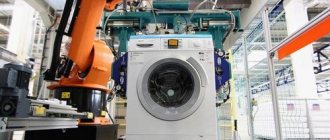For heating private homes and preparing hot water, double-circuit gas boilers are ideal. They work on the basis of transferring to the coolant the energy generated during the combustion of the most affordable and popular type of fuel. However, due to the extensive range of equipment, it can be difficult to choose. Do you agree?
We will tell you how to decide on the most suitable gas boiler model. The article we have proposed provides all the guidelines for choosing a unit with the highest possible efficiency that can withstand intense operating load. Market leading models and trusted manufacturers are listed.
Design features of the unit
A household gas appliance consists of a housing, two communication circuits, a built-in burner, a heat exchanger, an expansion tank, a combustion product exhaust unit, a gas valve and a control unit.
The main circuit is connected to the common heating system in a closed circuit. When the unit is actively operating in heating mode, the coolant circulates through the primary circuit pipes, but does not enter the hot water supply (DHW) communication system, since the path there is blocked by a special valve.
When installing equipment with two circuit elements, you must remember that the length of the communication pipe connecting the boiler to the farthest point of water intake should not exceed 7 meters. Otherwise, mineral elements deposited in the form of scale in the heat exchanger area will begin to interfere with the movement of the working fluid and the productivity of the water heater will significantly decrease
When the user turns on a hot tap in the kitchen or bathroom, the valve is activated, closes the entrance to the heating pipes and directs the coolant to the DHW circuit to warm up the water in the heat exchanger.
From there, the liquid enters the tap and is used for its intended purpose. When there is no longer a need for hot water and the tap is closed, a reverse switch occurs and the valve again redirects the coolant to the heating circuit.
Operating principles
There are convection and condensation gas boilers.
In convection chambers, the coolant is heated in the fuel combustion chamber. In condensation chambers, in addition, the heat obtained as a result of the accumulation of steam is used.
Classification by installation location
According to the installation principle, boilers serving two communication circuits are floor-mounted, wall-mounted and parapet-mounted. Each option has its own special characteristics.
Based on them, the client can choose the most suitable installation method for himself, in which the equipment will be conveniently located, will not “eat up” the usable area and will not cause problems during operation.
Floor-standing boilers
Floor-standing units are high-power devices that can heat and provide hot water not only to a standard apartment or residential building, but also to a large industrial premises, public building or structure.
If a double-circuit boiler is planned to be used not only for heating and supplying domestic hot water, but also for replenishing warm water floors, the basic unit is equipped with an additional circuit
Due to their large size and significant weight (up to 100 kg for some models), floor-standing gas boilers are not installed in the kitchen, but are placed in a separate room directly on the foundation or on the floor.
Features of wall equipment
A mounted appliance is a progressive type of household heating equipment. Due to its compact size, a geyser can be installed in the kitchen or other small rooms. It can be combined with any type of interior solution and fits organically into the overall design.
A double-circuit wall-hung boiler can be placed not only in the kitchen, but also in the pantry. It will take up minimal space and will not interfere with furniture or other household appliances
Despite its small size, a wall-mounted boiler has the same functionality as a floor-standing device, but has less power. It consists of a burner, an expansion tank, a pump for forced movement of the coolant, a pressure gauge and automatic sensors that make it possible to use the fuel resource with maximum efficiency.
All communication elements are “hidden” under a beautiful, modern case and do not spoil the appearance of the product.
The flow of gas to the burner is controlled by a built-in safety system. In the event of an unexpected interruption of the resource supply, the unit’s functioning completely stops. When fuel starts flowing again, the automation automatically activates the equipment and the boiler continues to operate in standard mode.
The automatic control unit allows you to set the device any operating parameters that are most suitable for the user. It is possible to set your own temperature conditions for different times of the day, thus ensuring economical consumption of fuel resources.
Nuances of parapet devices
A parapet boiler is a cross between a floor-mounted and a wall-mounted unit. It has a closed combustion chamber and does not create harmful emissions. Does not require the installation of an additional chimney. The combustion products are removed through a coaxial chimney laid in the outer wall.
A parapet-type boiler is the best option for heating equipment for small rooms with a weak ventilation system. The device is designed so that during operation it does not emit combustion products into the atmosphere of the room in which it is installed.
The device is mainly used to provide hot water and full heating to small houses and apartments in high-rise buildings where it is not possible to install a classic vertical chimney. The basic power ranges from 7 to 15 kW, but despite such low figures, the unit successfully copes with the assigned tasks.
The main advantage of parapet equipment is the ability to connect heating and water supply communications to the central gas system and pipelines from any side convenient for the user.
Condensing boilers for low temperature heating systems
Having appeared relatively recently, “warm floor” systems are now becoming increasingly common as the main ones, especially in new houses and apartments with individual heating. They manage to implement them even on wooden joists, not to mention slab foundations, ground floors and concrete floors. The main difference between a heated floor and a radiator piping is not even the laying of the line in the screed, but the low temperature of the coolant and efficiency due to lower fuel consumption and high thermal inertia. Traditional gas boilers are used in such systems, but a condensing boiler will work more efficiently in it. It is characterized by increased efficiency due to the removal of thermal energy from flue gases, but in order for the equipment to function at full efficiency, the temperature in the “return” must be less than 55˚C. And these are just the parameters of warm floors or warm walls, but the latter are practically not found in our country.
In tandem with a heated floor, a condensing gas boiler will allow you to consume less gas, which is vitally important given the enviable stability of tariff growth. Condensing boilers also have one more undoubted advantage - the ability to operate at a power several times lower than the nominal one. Do not clock, switching on and off, but work in optimal mode.
SirazhudinForumHouse Member
I laid 70 square meters in my apartment. pipes for TP made of cross-linked polyethylene, 20-diameter, 5 circuits, about 400 m. In general, the next stage is choosing a boiler, since I only have a heated floor without radiators, I decided to buy a condensing type boiler. The store told me that they have a 400 sq.m. condensing boiler. So the question is, is it possible for me to install a boiler with such a reserve on my 70 sq. m. and will it work correctly?
Sergey BugaevProduct Specialist
It is better for you to pay attention to boilers of lower power; 24 kW will be enough. In general, gas condensing boilers have a higher modulation range, and they can easily operate in a small area even in spring and autumn. With a minimum power of 2.4 kW it will correspond to 24 kW.
The latest generation wall-mounted condensing boilers are characterized not only by efficiency and a large modulation range, but also by expanded functionality.
- Efficiency – up to 109.8%.
- Energy efficiency – A+.
- Weather-dependent regulation - maintains a constant temperature in the rooms, reducing or increasing power, depending on the ambient temperature.
- Built-in Wi-Fi module, remote control.
- Possibility of integration into a smart home control system.
Even the most reliable European equipment needs service in order for the boiler to be guaranteed; the installation must be trusted not just to professionals, but to certified installers. The process itself does not require any special manipulations, there is only one nuance.
polshinForumHouse Member
...Is the boiler piping and installation of the heating system of a condensing boiler very different from a conventional one?
Sergey BugaevProduct Specialist
There is only one difference: condensing boilers have condensate drained into the sewer system. This is a small tube through which condensate flows in a weak stream.
If we are talking about a private house with local treatment facilities, condensate in its pure form cannot be discharged into the sewer system. It must be pre-treated in a specialized neutralizer (a container with marble granules).
Model differences in power
Double-circuit boilers are divided by power into single-stage and two-stage. Single-stage devices always operate at a constant power level and use the same amount of fuel resource year-round.
This is not effective and entails excessive gas consumption, because a house or apartment requires high-quality heating for no more than 5 months a year. At all other times, running the equipment at full power is neither reasonable nor economically profitable.
When installing equipment with a base power of 30 kW, you should know that these types of devices should not be located in residential premises, but in separate rooms equipped with a high-quality ventilation system, individual access to the street and a full-fledged chimney
The functionality of two-stage devices is wider.
With it you can:
- regulate the gas flow regime and rationally consume fuel;
- reduce the number of on/off switches, thus reducing equipment wear and extending its service life;
- reduce the volume of harmful emissions into the air to a minimum.
Additionally, the device is equipped with a smooth switching module, which reduces energy consumption and allows you to simultaneously operate a boiler and a boiler of any capacity, installed separately.
Types of working gas burners
A gas burner can be atmospheric or pressurized. The first type has a simple design and does not produce any noise during operation. The module is cheap and, as a rule, is included in the basic package of the boiler.
Despite its simplicity, the atmospheric burner is very reliable and works well for a long time. Can be used both on budget devices and on expensive, “sophisticated” luxury products
The operating principle of an atmospheric burner is reminiscent of the operation of industrial hearth models. The fuel resource is supplied through an ejector and, due to draft, absorbs air from the surrounding atmosphere. Through a special hole, the mixture enters the combustion chamber and immediately ignites.
As a result, fiery tongues of flame with a very low actual temperature appear above the outlet holes, the task of which is to heat the coolant to the required level.
Pressurized (mounted) burners demonstrate a high level of efficiency, constantly maintaining the set temperature both in the coolant itself and in the hot water supply system, but they are much more expensive than their atmospheric counterparts.
However, these costs are justified, since the modules have expanded functionality and make it possible to use fuel resources as wisely as possible, without reducing the level of comfort of the home.
A pressurized (mounted) type burner is not included in the basic set of a double-circuit gas boiler. It is purchased separately and then installed on heating equipment
During full operation in pressurized burners, the air supply is forced, and its volume is very clearly controlled by internal automation. The module is installed in devices equipped with a closed combustion chamber operating with supercharging.
Fuel and air are mixed not inside the system, but at the outlet. The operating process of the device is almost completely automated and does not require human control.
Atmospheric burners are installed in dual-circuit heating devices with a power of up to 80 kW. Supercharged (mounted) modules are being implemented into large-sized units with a capacity of up to several thousand.
Principle of operation
A double-circuit gas boiler can operate in two modes - heating and water heating. The boiler itself has two circuits through which the coolant moves. One of them - with a primary heat exchanger - works for heating, the second - with a plate heat exchanger - for preparing hot water. Switching occurs using a three-way valve.
The exact operating mode of a double-circuit boiler is specified by the manufacturer, but usually the heating operating mechanism is as follows:
- When the room temperature drops below a certain level, the automation transmits a signal to turn on the circulation pump. The coolant begins to move, creating a vacuum in the return pipeline. At the same time the burner turns on.
- As the coolant flows through the heat exchanger, it heats up, spreading heat throughout the system.
- Running around the radiators, it cools down and returns to the boiler inlet at a lower temperature.
- It is heated again by passing through the heat exchanger.
- When the set temperature is reached (there is control by the coolant temperature, there is control by the room temperature), the burner turns off, the coolant circulates for some time, adjusted by the circulation pump (post-circulation mode). When the heat exchanger temperature drops to a certain level, the circulation pump stops. The boiler does not operate as long as the temperature is within normal limits. As soon as it becomes 1°C below the set limit, the boiler turns on again.
Different operating modes of double-circuit gas boilers
With some variations, this operating algorithm is repeated in different boilers. When heating water for domestic needs, everything happens approximately the same, only the signal to turn on the burner is the appearance of water flow in the circuit. That is, you open the hot water tap, the burner lights up. Only in this operating mode does the three-way valve switch and close the coolant inside the boiler. The hot coolant heats the secondary heat exchanger, and from it the running water is heated. Heating stops when the water overheats (when the threshold value is reached) or after the tap is closed. The burner goes out, the circulation pump runs until the heat exchanger cools down, then turns off.
Types of ignition function
A household double-circuit boiler is started manually (using matches or a lighter) or using built-in elements (electric ignition or piezo ignition). The first method is the simplest and most accessible. The second makes it possible to save blue fuel by not leaving the wick in the igniter to burn constantly.
There is only one disadvantage of this option - dependence on the availability of electricity in the network. If for some reason the power stops flowing, the equipment immediately turns off and is automatically activated again when the electrical supply is restored.
Piezo ignition is absolutely safe and allows you to turn on the boiler by pressing just one button. The element does not depend on the supply of current and you can use the equipment even in the absence of electricity.
Equipment traction options
During operation of the unit, fuel burns and flue gases are generated. To remove them from a living space, natural or forced draft is necessary. It will ensure timely removal of all combustion products and released harmful substances from the apartment or house.
Natural draft modules
Boilers operating on natural draft have a simple design and take the air necessary for proper combustion from the room in which they are located. During intensive use, a certain amount of steam and various chemicals are released. Emissions are removed through a vertical chimney.
Among the main advantages of units with natural draft are reasonable cost, energy independence and absence of noise effects during operation.
In general, devices with natural draft are convenient and good, however, when the pressure in the gas pipeline drops, the quality of their work decreases significantly. At the same time, the risk of rapid burnout of the burner increases, since the fire at a reduced pressure level dies out or goes inside the burner device.
Uneven pressure in the main networks provokes serious overconsumption of fuel, which entails an increase in the amount of utility bills.
Forced draft devices
Boilers with forced draft are sometimes called forced-air or fan-type. They take air not from the room where they are located, but from the street. The modules have closed combustion chambers, and waste substances are emitted through a coaxial horizontal outlet using a powerful fan built into the system.
A coaxial bend consists of two pipe elements of different diameters inserted into one another. Through the smaller pipe, combustion products exit the room, and through the space between the small and large pipes, fresh air enters the room from the street, which is necessary for the full functioning of the boiler
Products with forced draft are easy to install, do not make any demands on the location, do not “eat up” oxygen in residential premises, work stably and accurately even with reduced gas pressure in the central main networks and do not require the installation of an additional vertical chimney.
The devices are criticized for the noisy operation of fan elements, higher cost and dependence on power supply.
Double-circuit gas boilers: manufacturers
Having decided on the technical characteristics, all that remains is to find a suitable model and choose a manufacturer. This is not at all easy - there are many companies on the market, prices vary considerably. As usual, there are three segments - expensive, mid-priced and cheap.
Expensive ones are products from European manufacturers:
- Italian gas boilers - Ferroli, Beretta, Ariston, Baxi.
- The German ones are not inferior to them in quality: Viessmann (Weissmann), Wolf (Wolf), Vaillant (Vialant).
- Korean Navien (Navien) are worthy competition to the leaders.
This equipment works reliably and without failures, but only under certain conditions. The first is a stable power supply, without significant deviations in frequency and voltage. Our networks lack stability, so a voltage stabilizer is needed, preferably an electronic one. The second condition for normal operation is a certain gas pressure in the line. Most German and Italian gas boilers operate if the gas pressure is 2 atm or more. The exception is the Ariston and Navien boilers.
Manufacturers of double-circuit gas boilers number in the dozens
Russian-made wall-mounted double-circuit gas boilers - Danko, Protherm - have proven themselves well on the market. They have approximately the same functionality as the “Europeans”, but react less sharply to deviations in the power supply and operate at low gas pressure. What is not pleasing is the Russian “service”.
There are also Bosch boilers. The company itself is German, but there are factories in Russia, so it’s not easy to determine the geographical location of these boilers - some are produced in Russia, some at other factories in other countries. Bosh campaign specialists have developed a new boiler model adapted to our conditions - Gaz 6000 W.
Distinctive features of heat exchangers
The heat exchange unit of the heating device can be cast iron, steel or copper. The cast iron version retains heat for a long time, is almost not subject to corrosion due to the high wall thickness and is resistant to aggressive coolants. It is heavy and therefore mainly integrated into floor-standing boilers.
Requires great care during installation, since any impacts violate the structural integrity of the material and lead to the formation of microcracks.
The steel structure weighs little, is not afraid of mechanical stress, can easily withstand temperature changes in the coolant, and is easily transported and installed. Has some tendency to corrosion. The boiler control system helps to avoid it, which prevents the coolant temperature from falling below the critical point.
Copper elements are an order of magnitude more expensive than their cast iron and steel counterparts, but they compensate for the substantial cost with a large number of advantages. Inside the copper heat exchanger, sediment and scale are formed to a minimum and do not interfere with the normal circulation of the working fluid. The walls of the device are heated evenly and do not cause local overheating of the coolant.
Advantages and disadvantages of gas systems
In places where central gas communications are laid, double-circuit boilers are very popular. They are purchased for heating and uninterrupted supply of hot water to apartments, residential buildings and country cottages.
The main advantages of the devices
The gas system demonstrates a high level of efficiency, delivers several times more energy than it consumes, lasts a long time and operates smoothly. Does not require constant human supervision.
The double-circuit boiler looks neat and modern. Unlike units operating on solid or liquid fuels, during operation it practically does not emit unpleasant odors and creates a minimum of soot and soot
The fuel resource is supplied to the installation continuously, and the built-in controller independently monitors the presence of fire on the burner. If the flame dies out, the sensor sends a signal to the ignition unit and the automatic supply of a spark instantly restores the fire. Controlling the boiler is simple and does not present any difficulty.
Disadvantages of dual-circuit equipment
The main disadvantages are associated not so much with the device itself, but with the process of its legalization and installation. You can’t just buy a boiler, bring it home and install it yourself according to the connection diagram. First, you will have to comply with a lot of technical nuances, draw up documentation and coordinate all subsequent actions with the local gas supply company.
There you will need to provide:
- equipment installation project, drawn up in accordance with the norms adopted by law;
- installation agreement with a specialized organization;
- a copy of the license of the specialized organization confirming the right to carry out work.
In addition, you will need to organize the removal of exhaust gas from the living space, lay an additional chimney for this or use an existing old one, and install additional equipment to control potential gas leaks.
If the boiler smokes, perhaps the pressure in the system has decreased or the existing burner has worn out and begun to burn out. A specialist with relevant experience will help you quickly fix problems
The main installation activities can begin only when the project documentation for the organization of gas heating has passed all stages of approval and the client receives a stamped permit for the installation of the system.
What is important to do before installation work begins?
Before purchasing a gas boiler for an apartment, there are requirements that must be met:
- obtain permission from the gas service to install heating equipment;
- select the room and location where the unit will be located;
- take care of the availability of high-quality ventilation;
- choose a coaxial chimney and think about how it will be laid.
You cannot install gas equipment in apartments:
- multi-storey buildings not connected to the main gas pipeline;
- where there are false ceilings and capital mezzanines.
To carry out installation, it is better to call specialists who have the right to perform such work.
Review of popular manufacturers and models
The market for modern gas equipment offers customers a large number of high-quality appliances designed for heating residential premises and supplying hot water.
Among the mounted units, the most popular are:
- Navien DELUXE 24K (South Korea) – efficiency, good functionality and reasonable cost;
- Baxi MAIN 5 24 F (Italy) – budget price, high level of efficiency, long service life;
- Vaillant turboTEC pro VUW 242/5-3 (Germany) – reliability, high-quality heat transfer.
In addition to the above qualities, the models are distinguished by their attractive appearance, compact dimensions, fit into a variety of interiors and can be easily placed even in small rooms with complex layouts.
A gas appliance with two circuits from the German company Vaillant has a convenient control knob and a display on which you can see the level of heating of the coolant at the moment
Of the floor-standing units, the most popular are the high-power (30 kW) ATON Atmo 30E, the practical Lemax Premium-25B and the more expensive, but very functional Navien GA 17KN.
Navien GA 35KN, despite its high power, uses fuel reasonably and allows owners to save on utility bills without compromising personal comfort
Baxi SLIM 2.300 Fi and Protherm Bear 40 KLZ are part of the premium line of equipment. They have advanced functionality and reliably serve for many years. In all parameters and physical characteristics they comply with the most stringent European standards (confirmed by certification certificate CSQ and UNI EN ISO 9001).
For a small room (up to 50 sq.m.), a boiler with a base power of 7 to 12 kW is suitable. If the real estate area is larger (for example, 150-200 sq.m.), it is better to purchase a 23-25 kilowatt device
Weak units simply cannot provide full heating to an apartment or large house.
You should buy floor-standing gas boilers and wall-mounted models only in branded stores or official representative offices of manufacturing companies. There, the client will be told in detail about the operating principles of this or that unit and will be helped to make the optimal choice.











